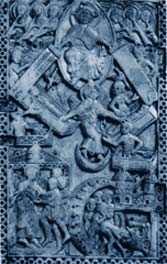Creation and Apocalypse provided the frame for a linear view of the world. The beginning and the end of this world also defined the process leading from one to the other - a process in which every person or event occupied a set position. In this constellation, the Apocalypse marks the ultimate future.
On the other
hand, death more or less![]() fixed the state of the soul until the Last Judgement in Anglo-Saxon belief.
Man would stand before God at the end of this world, in the same condition
- righteous or sinful - as at the moment of death, which therefore became
the apocalyptic moment itself. Death, now, is unpredictable. Any moment
can be the last of this life and thus the apocalyptic one. The apocalyptic
moment, which was simultaneously 'now' and 'then', was ever-present.
fixed the state of the soul until the Last Judgement in Anglo-Saxon belief.
Man would stand before God at the end of this world, in the same condition
- righteous or sinful - as at the moment of death, which therefore became
the apocalyptic moment itself. Death, now, is unpredictable. Any moment
can be the last of this life and thus the apocalyptic one. The apocalyptic
moment, which was simultaneously 'now' and 'then', was ever-present.
Such a thought was even more predominant in a society that was strongly aware of the transitoriness of all earthly things. Apocalyptic belief offered an answer to this dilemma: it offered the hope for immortality.
'As, then, there are two regenerations of which I have

already made
mention, the one according to faith, and which takes place in the present
life by means of baptism; the other according to the flesh, and which
shall be accomplished in its incorruption and immortality by means of
the great and final judgement, - so are there also two resurrections,
- the one the first and spiritual resurrection, which has place in this
life, and preserves us from coming into the second death; the other the
second, which does not occur now, but in the end of the world, and which
is of the body, not of the soul, and which by the last judgement shall
dismiss some into the second death, others into that life which has no
death.'![]()